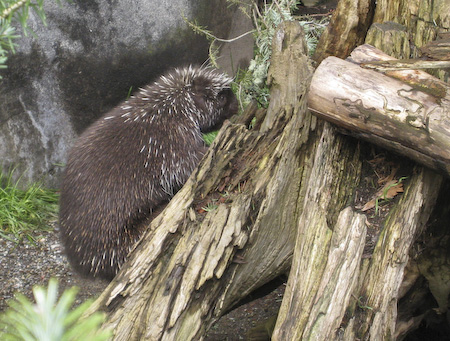 |
|
 |
|
Tracking
Quizzes
|
Quiz #47 - Answer
by Brian Booth |
|
|
1. The tree in Photo 47B is an EASTERN HEMLOCK. In New England, this tree
is distinguished from other conifers by its shape.
2. The mystery
animal is PORCUPINE.

3.
Clues that help support this conclusion include:
a. In New
England, porcupines have a strong preference for establishing dens in
boulder fields.
b. In New England during winter, porcupines have
a very strong preference for sprigs of eastern hemlock as their favorite
food. The hemlock shown in the photo shows extensive signs of being fed
upon. (Trees like this are sometimes called “hammer trees” because they
have basically been “hammered” by hungry porcupines.) That was a subtle,
but significant clue. (In other parts of the continent and in other
seasons, porcupines have a more varied diet and do not have a particularly
favorite food.)
c. Porcupines deposit their scat around the
entrances to their dens. If they’ve been living there a long while, there
can be rather enormous piles of scat.
d. Porcupines scat is
fibrous, especially in winter when they tend to eat mostly twigs and
conifer leaves. The scat is often macaroni-shaped, and generally is not
stinky – in fact, it can actually have a fairly pleasant aroma, depending
on what they have been eating.
e. The item shown in Photo 47H is
a porcupine quill, which can generally be found along with the scat. This
is a dead giveaway that the animal was a porcupine.
Porcupines are
unique and interesting animals. They are slow, quiet and gentle, although
they can do a lot of damage. I was once hiking in a canyon in Alberta and
encountered a porcupine that was chewing away at the supports for a wooden
bridge that was high above a raging stream – if the bridge collapsed while
someone was crossing it, they would almost certainly perish. Porcupines
have poor eyesight and limited brainpower, but are able to locate and
identify hemlock trees more effectively than your average human!
I
have found the easiest way to find porcupines is to investigate boulder
fields that are in the vicinity of hemlock trees. You can learn amazing
things from a pile of rocks!
So, considering there weren’t any
tracks present in this quiz, was it really “tracking”? Experienced
trackers will tell you definitively YES, that tracking involves searching
for all kinds of signs of animals, whether it is footprints, feeding sign,
dens, trails, scent-marking, claw marks, or scat. I best heard it
described by Tom Brown Jr, who remarked that his mentor, Stalking Wolf,
said the Apache word for looking for signs of animals translated more
closely to the English word "awareness" rather than "tracking", although
there wasn’t really an English word that fully captured the meaning of the
Apache word. This has been a source of inspiration to me to expand my
awareness and observation of the world – the more I look for, the more I
learn.
Hope you all get in some good "dirt time" before the next
tracking quiz.
BRIAN |
| |
Quiz #47 - Question ...on to
Quiz #48 |
| |
|
(All photos on this page are Copyright © by Brian Booth
or Walter Muma unless indicated otherwise)
To send comments, questions or feedback about these quizzes,
email me |
| |
|
Tracking Quizzes |
| |
|
|